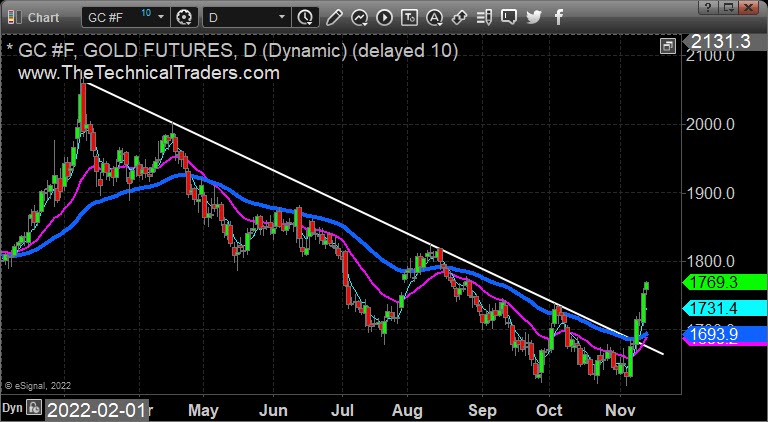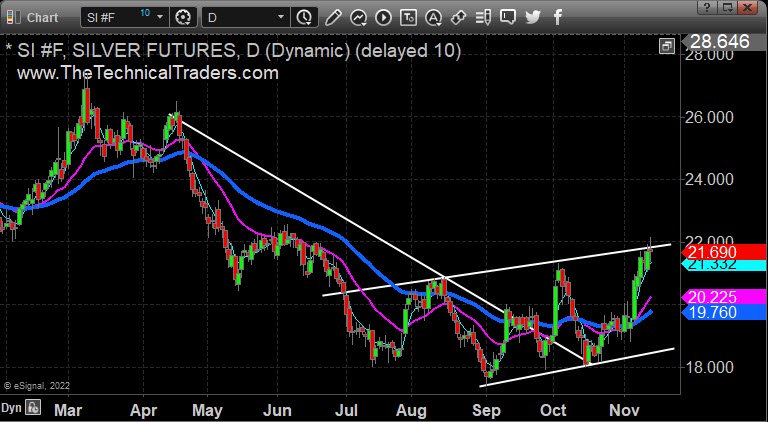Precious metal prices—gold, silver—and related miners have been bearish for quite some time now. It looks like that is starting to change.
When I look at the charts for gold and silver, I see similar periods of consolidation with multiple tests of support. But even more interesting is the recent upturn in price and moving averages with some new higher highs. That makes me interested but tentatively bullish on the metals.
There are many ways to participate in this sector. There is, of course, physical metal—bullion or numismatics. I’ve always liked the idea of having some physical metal that I can put my hands on. And there are many secure storage options as well.
The metals sector has several popular ETFs—SPDR Gold Shares (NYSE:GLD), VanEck Gold Miners ETF (NYSE:GDX), VanEck Junior Gold Miners ETF (NYSE:GDXJ), iShares Silver Trust (NYSE:SLV), ETFMG Prime Junior Silver Miners ETF (NYSE:SILJ), etc.
One approach would be to simply buy shares in whichever one is the best asset now (BAN) one or more of these ETFs. That’s as easy as buying shares of stock. But, like owning stock, gains may be slow to come as we participate in the price action tick for tick.


As an options trader, I like to give myself a little room to be wrong on price and reduce my cost basis by selling option premiums. There are two basic ways to do that. I can buy shares and sell “covered calls” against those shares. Or I can sell puts, essentially committing to buy shares at the strike price in return for receiving an option premium. The profit and loss graph for selling a put is the same as for selling a covered call.
I prefer the “selling puts” strategy for its simplicity and relative ease of rolling out in time and up in strike price when there is an uptrend in the underlying shares. I don’t own any shares with this strategy. I’m just committing to buy shares at a certain price for a specific time period and getting paid to do that. So, it’s important to only sell puts for the number of shares I’m willing to own at the strike price sold.
Selling Puts for Consistent Income
While the option selling strategies presented here can work on any stock or ETF that has options, they work best with relatively lower-priced products that are under about $25. A commodity ETF such as SLV – currently trading around $20 a share — is a good candidate. SILJ at around $10.50 a share also looks good.
If we sell puts, we may see shares “put” to us at some point and will then own the shares at the strike price we sold minus the premiums collected. Having shares put to us at a reduced-cost basis is part of the plan. When we sell an out-of-the-money (OTM) put, we’re methodically nudging the statistics in our favor by “buying low” when there is a pull-back in the underlying. We can alternately think of selling a put as a standing limit order to buy shares with the limit price equal to the strike price we sold.
If we have shares “put” to us, we can then sell calls against the shares we now own. And the cost basis of the shares we purchased will have been reduced by the cumulative option premium collected by selling puts.
Trade Management
Writing puts and covered calls are relatively low-maintenance strategies that don’t have to be watched continuously. Once we write options, we do have to be patient and let time decay in the options we sold work for us.
If the options we sold expire worthlessly, we can sell new options for some future expiration cycle and collect more premiums.
If our sold options are in the money (ITM) as expiration approaches, we can defer an assignment by rolling it out for additional credit. In that case, we would buy back the option close to expiration and sell another one further out in time. We can usually do this for an additional credit because we are selling more time value.
Upside and Downside Risks
As with any strategy, it’s important to ask and understand “What could possibly go wrong?” before getting involved. Selling puts and writing covered calls are neutral to bullish strategies. There can be sustained down trends, price shocks, and changes in volatility that can affect strategy performance.
There’s always a tradeoff when selling options. In exchange for collecting option premium, profit is limited to the amount of premium collected plus any appreciation in shares up to the strike price in the case of covered calls. We may not have a great opportunity to sell option premiums in every possible cycle.
Keeping probability in our favor and letting time decay work for us are benefits of selling a put or covered call. As option sellers, we don’t need large up moves to make a profit. We have the statistical odds in our favor and option time decay working for us. The underlying share price can go up, sideways, or even down a bit, and we can still profit.
